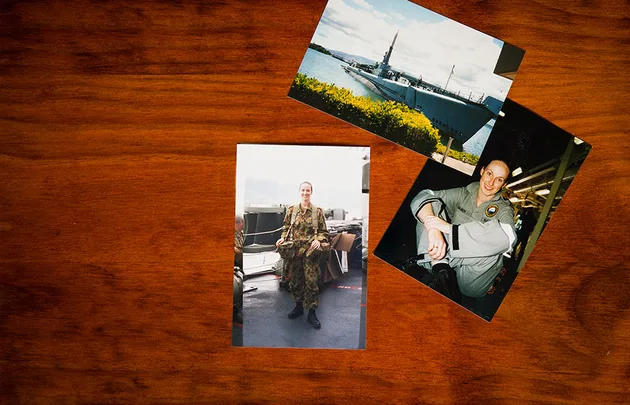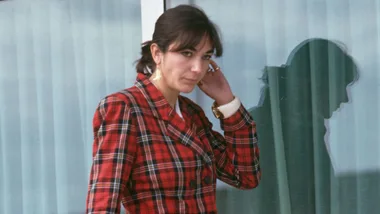Standing by the helipad at the Townsville army barracks on June 13, 1996, as a black dot appeared in the sky and the familiar thwack of helicopter rotor blades reached her ears, Private Calli Morgan began to shake. With every muscle tensing up, she couldn’t swallow, let alone think about moving. “When the [helicopter] arrives, I want you to take the bodies off and put them on the back of the vehicle,” an officer gently instructed Morgan, a truck driver, and a dozen or so other soldiers.
“Let’s just get this done. Look after the men who have passed away.” The soldiers made eye contact with one another. “Don’t cry, don’t cry, don’t cry,” Morgan silently willed herself. The previous night, two Black Hawk helicopters had collided in the highrange training area behind the North Queensland military base. Both caught fire, and one crashed. Eighteen personnel were killed.
It was the worst accident in the history of Australia’s elite Special Air Service Regiment. Though word of the accident had spread through the base, the first Morgan knew of casualties was at the helipad, where she was handed two pairs of gloves – one surgical, the other elbow-length and heavy-duty.
As the rescue helicopter shuddered to the ground, through the open rear door Morgan could see rows of body bags. “Sadness overwhelmed me,” she recalls now, from her home in Adelaide. “It was like someone was dropping a car on me. I just kept thinking there are people at home crying over these men. Has anybody held them? Has anybody held these poor men?”
So, as the men were taken from the chopper, “I just put my hands underneath and tried to hold them as compassionately as possible. My heart burst. There were just so many of them.” The bodies had been out in the bush overnight. “It was,” relates Morgan, “brutally confronting.”
“My heart burst. There were just so many of them.”
Private Calli Morgan
Over a two-day retrieval operation – 11 arrived on that first day – Morgan and her colleagues ferried the bodies to the morgue where, once identification was complete, they were placed, one by one, in a row of chrome coffins. Shutting the lids “was the hardest part”, she reveals. “You felt like you were shutting off their air. I know how stupid that sounds, but it was the most horrible thing to do. That’s what comes back to me in a lot of my nightmares.”
Morgan was not a battle-hardened soldier – she had joined the army just a few months earlier. When she signed up, she had never lived away from her family, let alone seen a dead body. Morgan had just turned 21. “It was too much. It was just too much.”
In 2009, after 13 years of depression, paranoia, panic attacks, social isolation, flashbacks, failed relationships and nights where it was easier to stay awake than submit to the terror of sleep, Morgan was diagnosed with post-traumatic stress disorder (PTSD), one of the most prevalent – and possibly the most under-reported – mental illnesses in Australia today.
While recent media focus has been on servicemen with PTSD, “nobody is aware of us [women]”, says Morgan, who also spent six harrowing months in an active peacekeeping role in East Timor in the violent lead-up to independence from Indonesia. Despite establishing a Facebook support group for female veterans, “this is the first interview I’ve ever done”.
According to a 2010 study by the Australian Defence Force (ADF), about 10 per cent of its serving female members – at that time 684 women – have PTSD, just a percentage point higher than the reported incidence among women in the wider community.
“I don’t believe that in a million years,” argues Katie Tonacia OAM, co-founder of PTSD education and awareness group Picking Up The Peaces. She believes the number is much higher and blames a combination of stigma – even self imposed – and the fear of committing “career suicide” for the under-reporting of mental health issues in the military. “I can’t be seen to be weak, I’m not going to come forward, I’ll push through it no matter what … until they get to breaking point.”
Rear Admiral Robyn Walker, commander joint health and surgeon general for the ADF, admits PTSD is a problem, but is at pains to distance the Defence Force from it. “It’s not about being in the military, it’s not about being on deployment,” she tells marie claire.
“I’m not saying that in some cases it won’t be after one [traumatic event], but the evidence suggests [PTSD] is about lifetime exposure … car accidents, domestic violence, sexual assault … The data shows that many of our members have been exposed to those types of things before they joined the military.”
“That is misleading,” retorts Brisbane psychiatrist Dr Andrew Khoo, who treats many current and former military personnel. “If you purely look at the diagnostic criteria for the disorder, you only need a one-off event. I’ve got innumerable patients who’ve just had a one-off, terrible trauma and they’ve got PTSD.”
Morgan is also puzzled by Rear Admiral Walker’s assertion. “When I went into the military I was assessed by a psych for an hour,” she comments, “and I was perfectly sound to them. That’s with full disclosure and answering all of their questions.” Dr Khoo believes the ADF’s biggest problem “is identifying the illness and then basically engaging people in treatment”. Like Tonacia, he blames magnified stigma in the military service, “because it’s a male-dominated, misogynistic, competitive atmosphere where strength is very much celebrated and weakness isn’t tolerated”.
“It’s a male-dominated, misogynistic, competitive atmosphere”
Dr Andrew Khoo
When Morgan finished her work at the morgue that Friday night in 1996, she sat in her room and stared into the middle distance “for hours”, ignoring repeated knocks on her door. In the weeks that followed, she and her colleagues underwent one group counselling session. They were fine, they all said. When Morgan reported for duty back in the transport yard, neither the Black Hawk accident, nor her role in the aftermath, were mentioned. “Nobody ever talked about it again,” she says. “It’s just the way we are in the army.”
Suzanne Baker has a dazzling smile. It lit up her first Royal Australian Navy ID card as an 18-year-old recruit. She’s still smiling, but at 33 there’s a brittleness to the grin and the infectious chuckle that follows it. “I get into trouble [with therapists] for the giggle because that’s [me] compensating for feelings,” reveals Baker, an aircraft systems controller who was medically discharged from the navy with a back injury nearly six years ago.
Baker can trace those feelings back to January 2000 and the horrors she witnessed during a seven-week deployment as a peacekeeper in East Timor. Months earlier, militia opposed to impending independence from Indonesia had embarked on a murderous spree, leaving behind mass graves, wholesale destruction of buildings and starving, orphaned children. Baker doesn’t want to talk about what she saw, but it sowed the seeds of a mental illness that almost destroyed her life. Before she disembarked in the capital, Dili, the only woman among “a couple of hundred army guys”, she’d only once been north of Brisbane. She was 19.
She was also bright and ambitious with an exciting career looming – the sort you see in the recruitment ads: sharp uniform, solid mates, a good education and a chance to see the world.
But a film charting Baker’s career wouldn’t look like the ads. Set in locations like Christmas Island and the Persian Gulf, it would feature desperate, self-harming asylum seekers, a few sexist shipmates, some callous superiors, several bullies, then, just before the credits rolled, a compassionate officer and some solid-as-a-rock friends. And tears. Lots and lots of tears.
Looking back, Baker says PTSD first “bit her on the bottom” 18 months after East Timor. By then a specialist in radar and electronic warfare, she was rendered catatonic after catching a whiff of a clove cigarette while on patrol near Christmas Island. “The smoke. That smell. I was straight back in Dili,” she says. A friend described Baker’s face flushing, then draining of colour, before she went into a kind of daze.
Later on that same border protection deployment, “a few things from Timor started to tickle the back of my mind”, recalls Baker. She was also exhausted, homesick, shattered by the work she was doing, and enduring harassment from a male colleague.
Suddenly, sitting at her console, “the tears started rolling and didn’t stop”. Eventually escorted to the sick bay, Baker says she sobbed for two days. The following year, having qualified as an aircraft controller, Baker was deployed to a frigate in the Persian Gulf, monitoring oil sanctions against Iraq.
“The tears started rolling and didn’t stop”
Suzanne Baker, Former aircraft systems controller
Six days into her new job, a helicopter she was guiding onto a neighbouring vessel crashed on landing, burst into flames and rolled into the water. All onboard survived, and Baker was cleared of any responsibility, but her confidence was shattered.
Six weeks later, when another helicopter crashed – Baker was not on duty – shipboard life became a series of emotional meltdowns. When she was stood down with exhaustion, a common trigger for her tears, others would have to pick up the slack.
One day, as she was being comforted by a sympathetic male colleague, a woman on a neighbouring console suddenly began screaming: “You useless c**t! Quit freakin’ crying!” But Baker couldn’t. She was as confused as her shipmates were angry. Rushing from the room, she headed downstairs towards her cabin. When her heel caught on a step, she made a split-second decision not to save herself and plunged headfirst to the next deck.
“I thought that topping myself would be better than putting up with another day of that,” she admits. Even before her suicide attempt, Baker had seen psychiatrists, but none, she found, could relate to what she’d seen and done during her service. One doctor, she recalls, “kept asking about my ex-boyfriend. I didn’t want to talk about this guy; I had nothing to say!”
Baker finally left the navy in 2008, sidelined by a back injury (unrelated to her fall). Working as aircrew for Surveillance Australia, she began having nightmares and flashbacks “and panic attacks while I was flying; not really too safe for any of us”. She was diagnosed with PTSD in 2012 – 10 years after attempting suicide.
Post-traumatic stress is a psychiatric disorder that is triggered by a specific traumatic event that a person has either experienced or been exposed to. It can also occur after prolonged exposure to traumatic situations. Symptoms include intrusive memories, nightmares, flashbacks, hypervigilance, emotional numbness, irritability, impatience, intolerance, poor anger control, insomnia and depression, plus physical anxiety symptoms like rapid heart rate. “It is,” stresses Dr Khoo, “a significant diagnosis.”
He says women in the general community develop PTSD at twice the rate of men. (Not so, apparently, in the ADF where, Rear Admiral Walker maintains, “there is no statistical difference” between genders.) Dr Khoo says no more than 25 per cent of people “suffering even the most horrific traumas will go on to develop PTSD”.
While factors such as genetics, temperament and childhood experiences play a role, what actually tips some into that 25 per cent is at the heart of reforms that many want the ADF to intensify. “Things like, how prepared for the trauma were you prior to it happening?” explains Dr Khoo. “How supported were you around the time the trauma actually occurred? How much education did you have about how to best access help or help yourself at the time?”
“It’s not rocket science,” says Katie Tonacia of Picking Up The Peaces. She believes peer-to-peer education is essential, delivered by those who’ve been supported to stay in the job. “At each [rank], you need somebody talking about their experiences … when you first start not sleeping, before the drugs and alcohol, before everything starts to fall apart, when you first notice those very simple basic signs and symptoms, come forward then and not be in fear of losing your job.”
Rear Admiral Walker says while “the big issue is that people say they’re all right when they’re not”, since 2002, “we’ve certainly changed the way we address mental health”. She cites increased resources and training, a boosted mental health workforce and two “mental health days” in 2012–13, “a day put aside where command and medical people talk about mental health
and what it means. It’s where we’ve had videos of people who’ve got mental health conditions who tell their own story and what has happened to them.”
Is PTSD curable? “PTSD is a very treatable condition,” says Dr Khoo, “[but] I don’t know if you can ever completely eradicate a memory and a memory is what this is predicated upon.”
The memory that haunts Sarah Archibald, who spent seven months in Iraq in 2006 as a corporal in the Military Police, is that of a battle – not involving the enemy, but a scarring tussle between her training and human empathy. Positioned at a checkpoint securing both the Australian Embassy and a Baghdad hospital, her role was to pat down visitors seeking to enter either.
One morning, a little girl arrived on a stretcher with horrifying injuries from a bomb and was rushed to the hospital. As Archibald searched her mother – there were no exceptions – word came through that the child had died. It was left to Archibald to break the news. “As she was hugging me and crying, I remember thinking, ‘I’ve got a job to do,’” says Archibald, now a mother of two girls. “All I wanted to do was hug this poor woman and I’ve got a weapon on my leg, and I was conscious of that as well. I just felt like I didn’t give her enough empathy.
“I particularly remember [the child’s] father looking at me with such anger. I still see his face today … If we weren’t there, this wouldn’t have happened. That’s what I think about.” At the time, the incident blended in with all the other trauma Archibald experienced, like diving under tables in the mess for fear of incoming rockets.
“I remember [the child’s] father looking at me with anger. I still see his face today …”
Sarah Archibald, PTSD sufferer
It wasn’t until she got home that the damage to her psyche became clear. Depressed, isolated and confused, she arranged to see a psychiatrist. The wait was six weeks. But Archibald didn’t have six weeks. She was spiralling into a deep depression. Before the appointment rolled around, she drove her car into a pole. Deliberately. Later, in hospital, Archibald was diagnosed with depression and “adjustment disorder”.
“I find that with males, particularly, [mental health specialists ask], ‘You’ve been overseas? Connect the dots: PTSD,’” says Archibald. “This is stereotyping, but a lot of guys choose alcohol or drugs … substance abuse is where they will head. Tick the box for PTSD.
“My battle was with eating disorders… That’s something I chose to cope and it wasn’t recognised that [PTSD] could be a contributing factor.” Archibald was diagnosed in 2009, when she revealed recurring dreams she was having about her own daughter.
Having been in treatment programs, Morgan, Baker and Archibald are now focusing on helping others. “We live in such a negative head and we have all these horrible memories, so we have to create our own happiness,” remarks Morgan, who now works as a disability support worker and has founded Women Veteran’s Association Australia to support women in the military.
“I know it sounds all very over-the rainbow, [but] you get to the point where you cannot bear the sadness so you just have to do something about it.” Baker has completed a tourism diploma and plans to open a holistic guided tour business aimed at the veteran community. And Archibald volunteers with Soldier On, a support group for physically and psychologically wounded military personnel.
Unlike Morgan and Baker, however, one thing Archibald doesn’t do is don her medals and proudly march on Anzac Day. “I don’t really feel comfortable,” she admits, then pauses.
“Sometimes … I feel like I don’t deserve to be there.”
If you or someone you know is suffering from PTSD, contact Lifeline Crisis support and suicide prevention services, 13 11 14, www.lifeline.org.au.
 supplied
supplied









